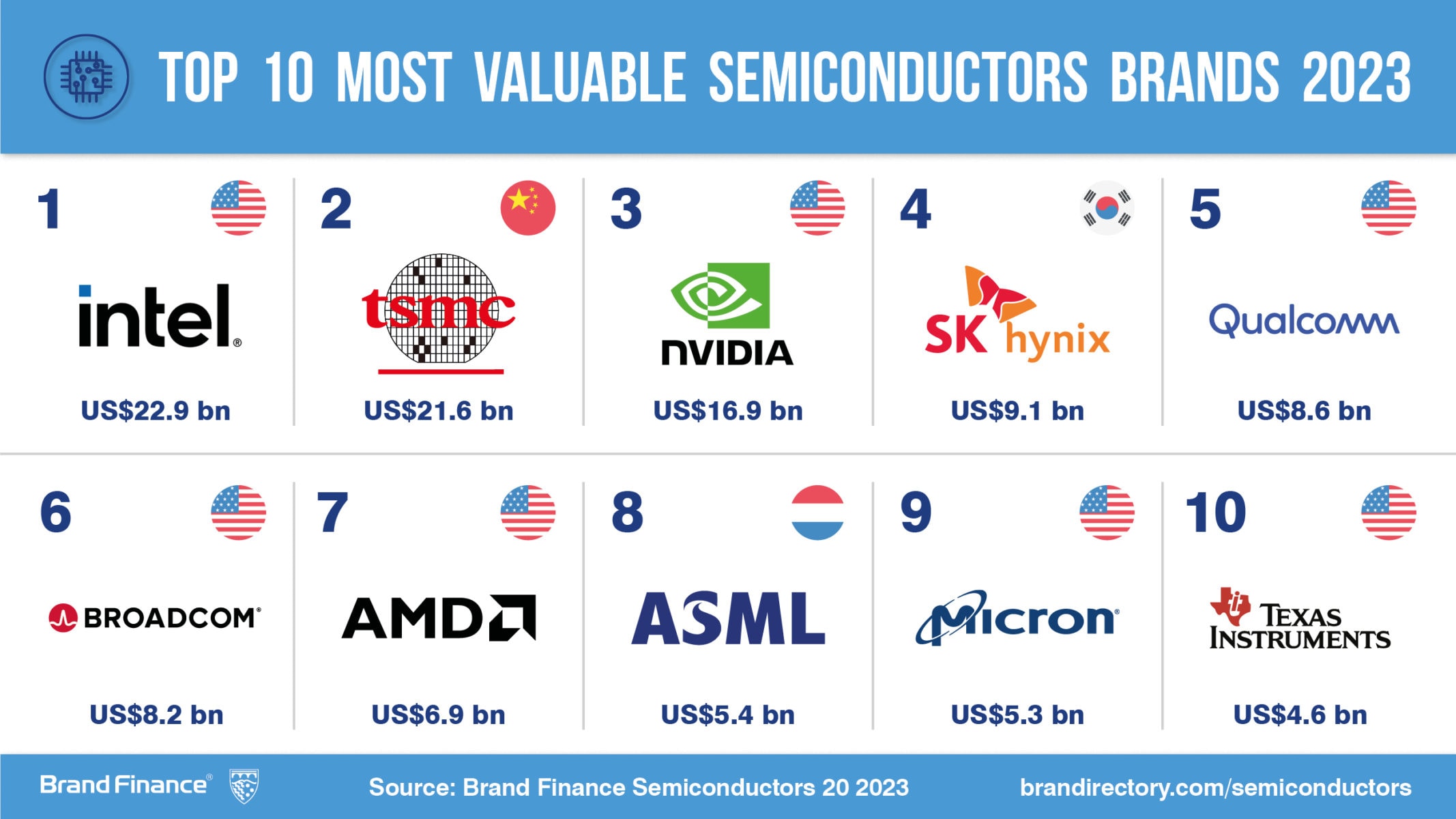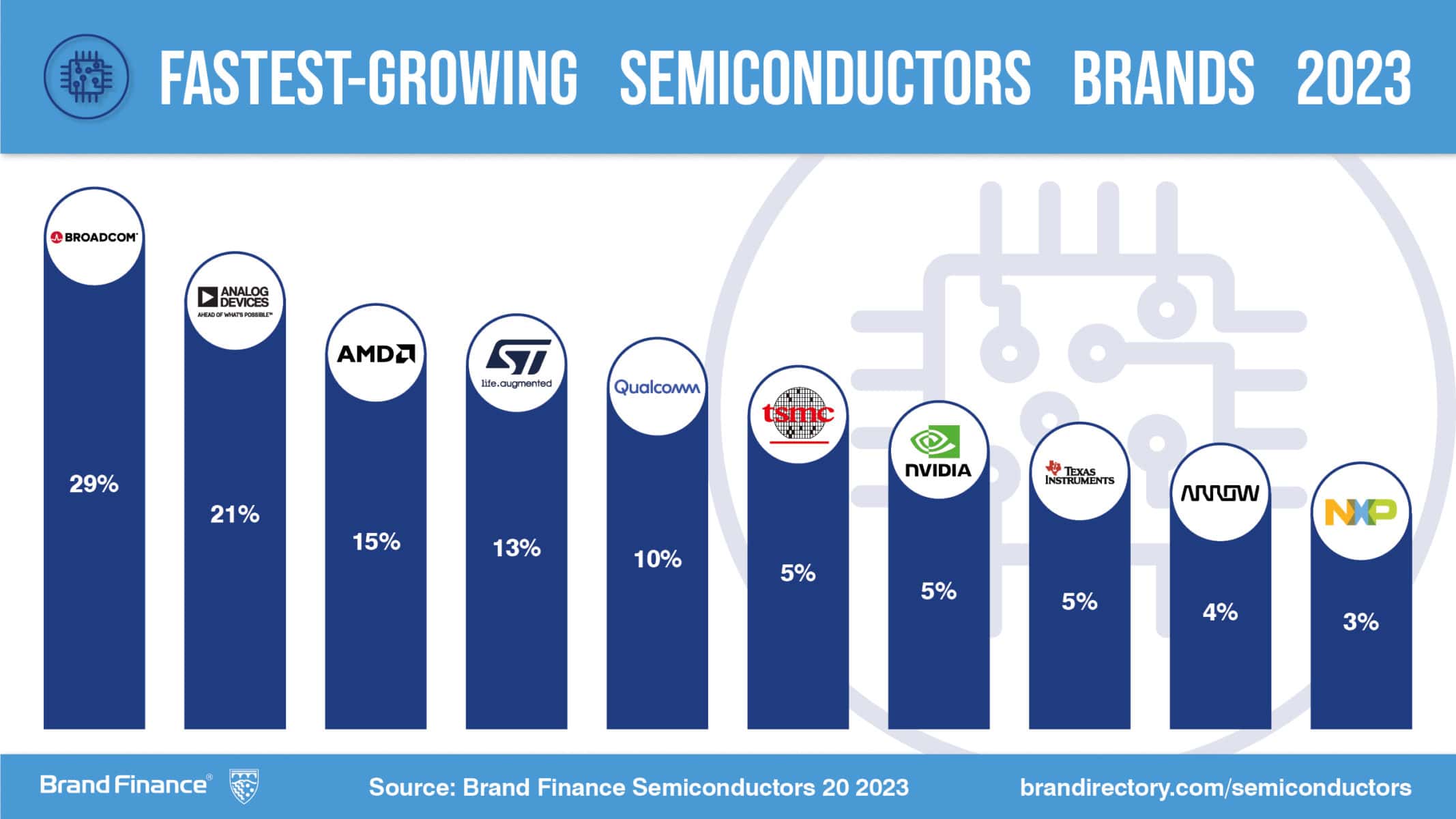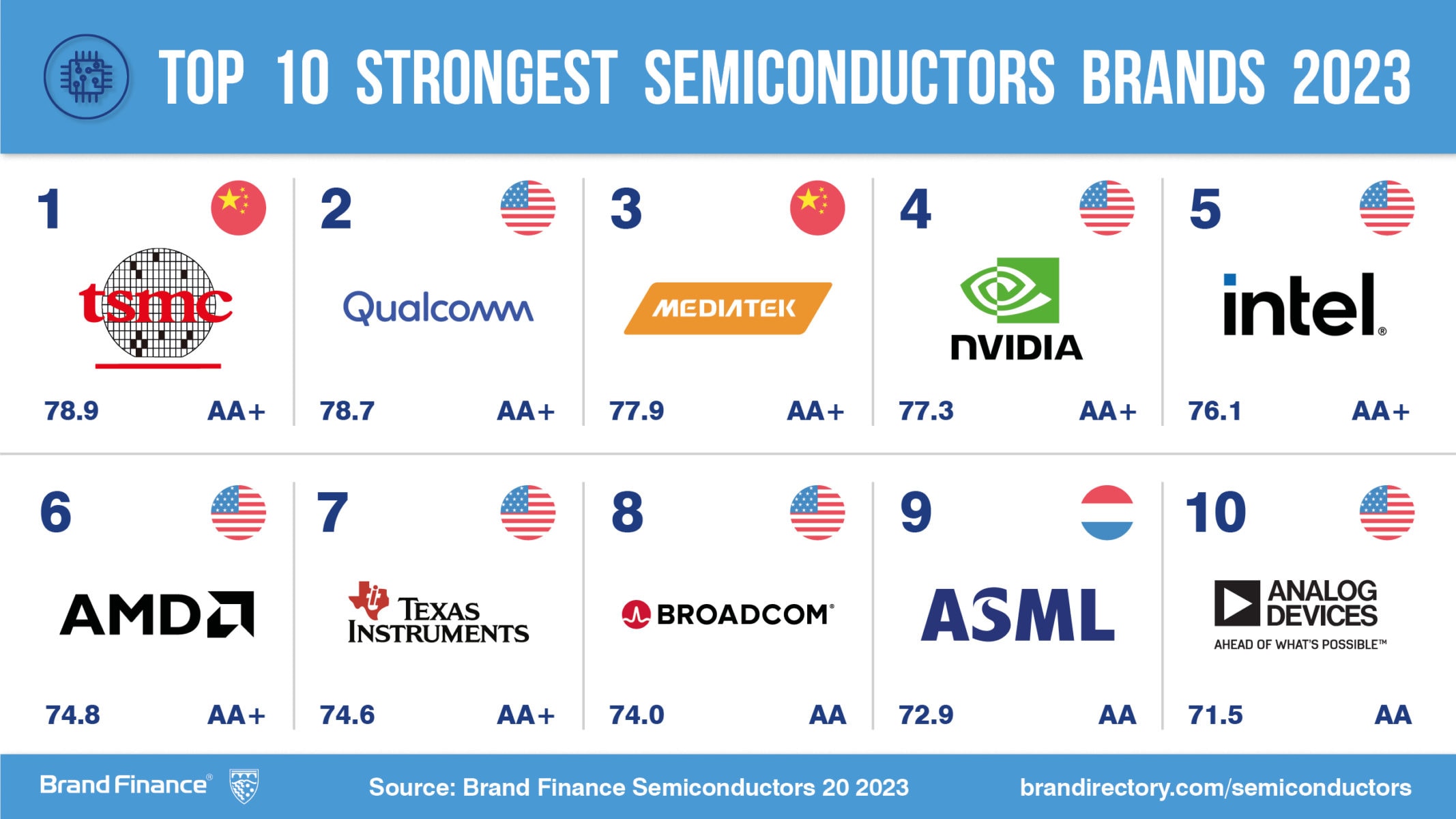View the full Brand Finance Semiconductors 20 2023 report here
Intel (brand value down 10% to US$22.9 billion) has barely retained its title as the world’s most valuable semiconductor brand, marginally ahead of TSMC (brand value up 5% to US$21.6 billion), according to a new report from leading brand valuation consultancy, Brand Finance. Intel has built a partially-consumer-facing brand based upon laptop and desktop computers (in addition to server and industrial markets), while TSMC is substantially a business-to-business brand dedicated to manufacturing semiconductors for Apple, AMD, Nvidia and mobile devices.
Every year, leading brand valuation consultancy Brand Finance puts 5,000 of the biggest brands to the test, and publishes over 100 reports, ranking brands across all sectors and countries. The world’s top 20 most valuable and strongest Semiconductor brands are included in the annual Brand Finance Semiconductor 20 2023 ranking.
Alex Haigh, Valuation Director of Brand Finance commented:
“Computing power – and efficiency – is an increasingly contested and important area in global trade, artificial intelligence, mobile computing, and politics. Obvious conflicts over the production, distribution and use of semiconductors are bubbling to the fore, a reflection of how important these brands are to the global economy. To maintain their brand strength and value, chip brands need to maintain their technological edge and production efficiency while also nurturing relations with governments interested in helping certain brands.”

Broadcom (brand value up 29% to US$8.2 billion) is the fastest-growing brand in the rankings this year, largely in connection with increasing demand for Broadcom’s networking and data devices. Broadcom has built a valuable business-to-business brand based upon deploying both wireless and wired connections for end users and network operators. The second-fastest growing brand in the ranking was Analog Devices (brand value up 21% to US$1.9 billion) which is a new entrant in the rankings.

AMD (brand value up 15% this year to US$6.9 billion) has achieved extraordinary brand value growth since the start of the COVID-19 pandemic. Valued at US$1.4 billion ahead of the pandemic period in early 2020, the brand is now worth almost five times as much, at just under US$7 billion.
STMicroelectronics (brand value up 13% to US$2.3 billion) is a major beneficiary of the global interest in smart devices, by manufacturing microchips for many distinct products, such as electric cars, factory machines, smartphones, and toothbrushes. In recent years, the brand value of STMicroelectronics has grown in connection with its strong brand portfolio, reliable distribution network, and supplier base.
In addition to calculating brand value, Brand Finance also determines the relative strength of brands through a balanced scorecard of metrics evaluating marketing investment, stakeholder equity, and business performance. Compliant with ISO 20671, Brand Finance’s assessment of stakeholder equity incorporates original market research data from over 100,000 respondents in 38 countries and across 31 sectors.
Despite TSMC’s brand strength falling slightly from a score of 80.3 to 78.9, TSMC has become the sector’s strongest brand. TSMC’s strength as a supplier of semiconductors is based in large part upon its fundamentally strong product: it operates much of the world’s leading semiconductor fabrication facilities as a result of its unique organisational knowledge and equipment.

ENDS
Brand Finance is the world’s leading brand valuation consultancy. Bridging the gap between marketing and finance, Brand Finance evaluates the strength of brands and quantifies their financial value to help organisations make strategic decisions.
Headquartered in London, Brand Finance operates in over 25 countries. Every year, Brand Finance conducts more than 6,000 brand valuations, supported by original market research, and publishes over 100 reports which rank brands across all sectors and countries.
Brand Finance also operates the Global Brand Equity Monitor, conducting original market research annually on 6,000 brands, surveying more than 175,000 respondents across 41 countries and 31 industry sectors. By combining perceptual data from the Global Brand Equity Monitor with data from its valuation database — the largest brand value database in the world — Brand Finance equips ambitious brand leaders with the data, analytics, and the strategic guidance they need to enhance brand and business value.
In addition to calculating brand value, Brand Finance also determines the relative strength of brands through a balanced scorecard of metrics evaluating marketing investment, stakeholder equity, and business performance, compliant with ISO 20671.
Brand Finance is a regulated accountancy firm and a committed leader in the standardisation of the brand valuation industry. Brand Finance was the first to be certified by independent auditors as compliant with both ISO 10668 and ISO 20671 and has received the official endorsement of the Marketing Accountability Standards Board (MASB) in the United States.
Brand is defined as a marketing-related intangible asset including, but not limited to, names, terms, signs, symbols, logos, and designs, intended to identify goods, services, or entities, creating distinctive images and associations in the minds of stakeholders, thereby generating economic benefits.
Brand strength is the efficacy of a brand’s performance on intangible measures relative to its competitors. Brand Finance evaluates brand strength in a process compliant with ISO 20671, looking at Marketing Investment, Stakeholder Equity, and the impact of those on Business Performance. The data used is derived from Brand Finance’s proprietary market research programme and from publicly available sources.
Each brand is assigned a Brand Strength Index (BSI) score out of 100, which feeds into the brand value calculation. Based on the score, each brand is assigned a corresponding Brand Rating up to AAA+ in a format similar to a credit rating.
Brand Finance calculates the values of brands in its rankings using the Royalty Relief approach – a brand valuation method compliant with the industry standards set in ISO 10668. It involves estimating the likely future revenues that are attributable to a brand by calculating a royalty rate that would be charged for its use, to arrive at a ‘brand value’ understood as a net economic benefit that a brand owner would achieve by licensing the brand in the open market.
The steps in this process are as follows:
1 Calculate brand strength using a balanced scorecard of metrics assessing Marketing Investment, Stakeholder Equity, and Business Performance. Brand strength is expressed as a Brand Strength Index (BSI) score on a scale of 0 to 100.
2 Determine royalty range for each industry, reflecting the importance of brand to purchasing decisions. In luxury, the maximum percentage is high, while in extractive industry, where goods are often commoditised, it is lower. This is done by reviewing comparable licensing agreements sourced from Brand Finance’s extensive database.
3 Calculate royalty rate. The BSI score is applied to the royalty range to arrive at a royalty rate. For example, if the royalty range in a sector is 0-5% and a brand has a BSI score of 80 out of 100, then an appropriate royalty rate for the use of this brand in the given sector will be 4%.
4 Determine brand-specific revenues by estimating a proportion of parent company revenues attributable to a brand.
5 Determine forecast revenues using a function of historic revenues, equity analyst forecasts, and economic growth rates.
6 Apply the royalty rate to the forecast revenues to derive brand revenues.
7 Discount post-tax brand revenues to a net present value which equals the brand value.
Brand Finance has produced this study with an independent and unbiased analysis. The values derived and opinions presented in this study are based on publicly available information and certain assumptions that Brand Finance used where such data was deficient or unclear. Brand Finance accepts no responsibility and will not be liable in the event that the publicly available information relied upon is subsequently found to be inaccurate. The opinions and financial analysis expressed in the study are not to be construed as providing investment or business advice. Brand Finance does not intend the study to be relied upon for any reason and excludes all liability to any body, government, or organisation.
The data presented in this study form part of Brand Finance's proprietary database, are provided for the benefit of the media, and are not to be used in part or in full for any commercial or technical purpose without written permission from Brand Finance.